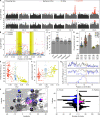Pan-European study of genotypes and phenotypes in the Arabidopsis relative Cardamine hirsuta reveals how adaptation, demography, and development shape diversity patterns
- PMID: 37463141
- PMCID: PMC10353826
- DOI: 10.1371/journal.pbio.3002191
Pan-European study of genotypes and phenotypes in the Arabidopsis relative Cardamine hirsuta reveals how adaptation, demography, and development shape diversity patterns
Abstract
We study natural DNA polymorphisms and associated phenotypes in the Arabidopsis relative Cardamine hirsuta. We observed strong genetic differentiation among several ancestry groups and broader distribution of Iberian relict strains in European C. hirsuta compared to Arabidopsis. We found synchronization between vegetative and reproductive development and a pervasive role for heterochronic pathways in shaping C. hirsuta natural variation. A single, fast-cycling ChFRIGIDA allele evolved adaptively allowing range expansion from glacial refugia, unlike Arabidopsis where multiple FRIGIDA haplotypes were involved. The Azores islands, where Arabidopsis is scarce, are a hotspot for C. hirsuta diversity. We identified a quantitative trait locus (QTL) in the heterochronic SPL9 transcription factor as a determinant of an Azorean morphotype. This QTL shows evidence for positive selection, and its distribution mirrors a climate gradient that broadly shaped the Azorean flora. Overall, we establish a framework to explore how the interplay of adaptation, demography, and development shaped diversity patterns of 2 related plant species.
Copyright: © 2023 Baumgarten et al. This is an open access article distributed under the terms of the Creative Commons Attribution License, which permits unrestricted use, distribution, and reproduction in any medium, provided the original author and source are credited.
Conflict of interest statement
The authors have declared that no competing interests exist.
Figures





References
Publication types
MeSH terms
Grants and funding
LinkOut - more resources
Full Text Sources
Other Literature Sources

